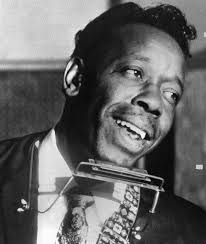Zydeco is a music genre that evolved in southwest Louisiana by French Creole speakers which blends blues, rhythm and blues, and music indigenous to the Louisiana Creoles and the Native American people of Louisiana. Although it is distinct in origin from the Cajun music of Louisiana, the two forms influenced each other, forming a complex of genres native to the region.
Louisiana blues is a genre of blues music that developed in the period after World War II in the state of Louisiana. It is generally divided into two major subgenres, with the jazz-influenced New Orleans blues based on the musical traditions of that city and the slower tempo swamp blues incorporating influences from zydeco and Cajun music from around Baton Rouge.
Electric blues refers to any type of blues music distinguished by the use of electric amplification for musical instruments. The guitar was the first instrument to be popularly amplified and used by early pioneers T-Bone Walker in the late 1930s and John Lee Hooker and Muddy Waters in the 1940s. Their styles developed into West Coast blues, Detroit blues, and post-World War II Chicago blues, which differed from earlier, predominantly acoustic-style blues. By the early 1950s, Little Walter was a featured soloist on blues harmonica using a small hand-held microphone fed into a guitar amplifier. Although it took a little longer, the electric bass guitar gradually replaced the stand-up bass by the early 1960s. Electric organs and especially keyboards later became widely used in electric blues.
The music of Louisiana can be divided into three general regions: rural south Louisiana, home to Creole Zydeco and Old French, New Orleans, and north Louisiana. The region in and around Greater New Orleans has a unique musical heritage tied to Dixieland jazz, blues, and Afro-Caribbean rhythms. The music of the northern portion of the state starting at Baton Rouge and reaching Shreveport has similarities to that of the rest of the US South.

Cajun music, an emblematic music of Louisiana played by the Cajuns, is rooted in the ballads of the French-speaking Acadians of Canada. Although they are two separate genres, Cajun music is often mentioned in tandem with the Creole-based zydeco music. Both are from southwest Louisiana and share French and African origins. These French Louisiana sounds have influenced American popular music for many decades, especially country music, and have influenced pop culture through mass media, such as television commercials.

Slim Harpo was an American blues musician, a leading exponent of the swamp blues style, and "one of the most commercially successful blues artists of his day". He played guitar and was a master of the blues harmonica, known in blues circles as a "harp". His most successful and influential recordings included "I'm a King Bee" (1957), "Rainin' in My Heart" (1961), and "Baby Scratch My Back" (1966), which reached number one on Billboard's R&B chart and number 16 on its broader Hot 100 singles chart.

Saunders Terrell, known as Sonny Terry, was an American Piedmont blues and folk musician, who was known for his energetic blues harmonica style, which frequently included vocal whoops and hollers and occasionally imitations of trains and fox hunts.
Swamp pop is a music genre indigenous to the Acadiana region of south Louisiana and an adjoining section of southeast Texas. Created in the 1950s by young Cajuns and Creoles, it combines New Orleans–style rhythm and blues, country and western, and traditional French Louisiana musical influences. Although a fairly obscure genre, swamp pop maintains a large audience in its south Louisiana and southeast Texas homeland, and it has acquired a small but passionate cult following in the United Kingdom, and Northern Europe

Clarence "Gatemouth" Brown was an American singer and multi-instrumentalist from Louisiana. He won a Grammy Award for Best Traditional Blues Album in 1983 for his album, Alright Again!.

Leslie Johnson, better known as Lazy Lester, was an American blues musician who sang and played the harmonica and guitar. In a career spanning the 1950s to 2018, he pioneered swamp blues, and also played harmonica blues, rhythm and blues and Louisiana blues.

Otis Verries Hicks, known as Lightnin' Slim, was an American blues musician who played Louisiana blues and swamp blues for Excello Records. The blues critic ED Denson ranked him as one of the five great bluesmen of the 1950s, along with Muddy Waters, Little Walter, Howlin' Wolf and Sonny Boy Williamson.

Joseph Denton "Jay" Miller was an American record producer and songwriter from Louisiana, whose Cajun, swamp blues, and swamp pop recordings influenced American popular culture.
Warren Storm was an American drummer and vocalist, known as a pioneer of the musical genre swamp pop; a combination of rhythm and blues, country and western, and Cajun music and black Creole music.
Cornelius Green III, known professionally as Lonesome Sundown, was an American blues musician, best known for his swamp blues recordings for Excello Records in the 1950s and early 1960s.
Silas Hogan was an American blues musician who played swamp blues and Louisiana blues. His most notable recordings are "Airport Blues" and "Lonesome La La". He was the front man of the Rhythm Ramblers. Hogan was inducted into the Louisiana Blues Hall of Fame.
"Chicago" Bob Nelson was an American blues musician.
Moses "Whispering" Smith was an American blues harmonicist and singer. He recorded tracks including "A Thousand Miles from Nowhere" and "Texas Flood" and worked with Lightnin' Slim and with Silas Hogan. He was inducted into the Louisiana Blues Hall of Fame.
Gabriel Perrodin, known as Guitar Gable, was an American Louisiana blues, swamp blues and swamp pop musician. He was best known for recording the original version of "This Should Go On Forever", and his part in the vibrant swamp blues and pop scene in Louisiana in the 1950s and early 1960s.







